- NEW DVD Series – Stone Setting with Bezels
- Tube Set Charm by Kim St. Jean
- Prong Basket Pendant by Kim St. Jean
- NEW DVD Series – Stone Setting with Cold Connections
- New DVD Series – Stone Setting with Wire
- NEW DVD Series: Introduction to Stone Setting by Kim St. Jean
- Featured Tool: Bracelet Bending Plier
- NEW Dvd by Eva Sherman
- Fun, Fast Fold Forming DVD Series
- Double Band Ear Cuff from Alex Simkin
Free Pattern: Seed of Change Pendant
by Judy Ellis, Wirejewelry.com
Wire Jewelry Pattern for June 5th, 2017
Seed of Change Pendant
by Abby Hook
This tutorial teaches you to make this reversible pendant. Learn to create a woven frame that skims one side of the bead, while on the other side only the outer structure wire is visible, giving the impression that the bead is poking out from the wire work. This pendant is 1 ¾” tall (including the bail) and ¾” wide.
I have included a rough guide for calculating the wire required for different sized beads.
Materials:
- 20 Gauge Round Half Hard .925 Sterling Silver Wire (Pattern Quantity – 15 Inches, Product ID: H8-20H )
- 28 Gauge Round Dead Soft .925 Sterling Silver Wire (Pattern Quantity – 78 Inches, Product ID: H8-28D )
- Mexican Red Snowflake Jasper 13×18 Oval Beads – 8 Inch Strand (Pattern Quantity – 1 Piece, Product ID: A1-587 )
- 4mm round beads Sterling Silver (Pattern Quantity – 1 Piece)
Tools:
- Chain Nose Wire Plier (Pattern Quantity – 1 Piece, Product ID: G2-508 )
- Round Nose Wire Plier (Pattern Quantity – 1 Piece, Product ID: G2-507 )
- Flat Nose Wire Plier (Pattern Quantity – 1 Piece, Product ID: G2-506 )
- Economy Nylon Jaw Pliers (Pattern Quantity – 1 Piece, Product ID: G2-25 )
Directions:
Step 1: Choose your bead. Flat oval beads work best.
This tutorial is based on the specific size stated in the materials list. Below I have given a rough guide for calculating the wire required if using a different size. Please note that the 28 gauge wire requirements can vary depending on how tightly you weave. These calculations are for a bail that is ½” tall when complete.
20 gauge
Measure the circumference of the bead, add 1” for the point at the bottom, and add 4” for the bail/leaf.
28 gauge
You will need approx: – 25” for the bail, approx 20” for every 1” of weaving on the frame and twice the length of your bead.
Tip: – I always allow extra wire when making something for the first time to ensure I do not run out of wire at a crucial point. You may want to consider this when making your calculations.
Step 2: Cut 2 pieces of 20 gauge wire, each measuring 7.5”. Make a sharp bend in the middle of them both, using the flat nose pliers.
Step 3: Pinch both points with the flat nose pliers creating a sharp point. Set one piece aside.
Step 4: Open the wire out to form a V shape, do this by holding the wire between your thumb and forefinger as shown, in both hands, bending the wire around your thumb slightly, whilst pulling the wire apart.
The bead should sit neatly above the V in the wire.
Step 5: Holding the bead carefully in place, shape the wire around it forming a leaf shape, so that the wires cross at the top. Ensure the point where the wires cross at the top is level with the V at the bottom. Set aside.
Note: – the frame should be slightly larger than the bead.
Step 6: Follow steps 4 and 5 to shape the other wire in the same way.
Step 7: Hold the bead inside the second wire so that the wire runs front to back and squeeze the wire together making the leaf shape narrower.
Notice how the smaller leaf shape now sits comfortably inside the larger one.
Tip – Take your time with these early steps, it is important to get the shaping right at this point as once you start weaving it will be difficult to adjust.
Step 8: Cut a piece of 28 gauge wire 23” long. On the larger leaf shape coil 3 times on the left of the V at the bottom, leaving a 1” tail.
Step 9: Insert the smaller leaf between the straight wires of the larger leaf, twist slightly so that the straight wires of the smaller leaf cross underneath the straight wires of the larger leaf. Bind together 3 times.
Tip – Turn the piece upside-down and hold the left side between thumb and forefinger to keep in place, use your fingers on this hand to guide the thin wire whilst weaving.
Notice how the straight wires form a square or oblong at the top.
Step 10: Holding the 2 leaf shapes in place as previously shown, coil the outer thick wire once with the thin wire, then take it over the outer thick wire and under the inner thick wire.
Step 11: Coil the inner thick wire once with the thin wire, then take the thin wire over the inner thick wire and under the outer one.
Step 12: Keep weaving in this manner:-
Coil, over, under
Coil, over, under
Tip: – Keep pushing the weave down the structure wires with your thumb nail to keep it tight.
Note: – Ensure that the crossover of the straight wires is always in line with the V at the bottom of the pendant, this will ensure that your finished piece is well balanced.
Notice the further you weave the more the pendant holds its own shape.
Step 13: Continue weaving until you reach the top, just before the wires cross. Coil the inner thick wire 3 times to secure.
Trim the end and the 1” tail and tuck the ends in neatly with the long nose pliers.
Notice how the weave has a tendency to spread more as the 2 structure wires curve together.
Step 14: Cut a piece of 28 gauge wire 30” long. Turn the wire structure over so that the unwoven side is on the left. Attach your new wire to the bottom of the outer wire by coiling 3 times, leaving a 1” tail.
Step 15: Bind the inner and outer thick wires together 3 times with the thin wire to secure in place.
Check that the design is the same both sides and carefully adjust the unwoven side to match the woven side if necessary.
Notice how rigid this makes the wire shapes.
Step 16: In the same way as before weave up this side: Coil, over, under. Until you are level with the weaving in the other side. Up at the top, coil the inner wire 3 times to secure. Do NOT trim the thin wire.
Step 17: Trim the 1” tail (leaving the length of 28 gauge wire attached) tuck the end in with the long nose pliers.
Step 18: Thread the oval bead and the 4mm silver bead onto the thin wire. Thread the wire through the gap between the 2 structure wires at the point and then back through the beads. Coil the nearest thick wire a couple of times to secure. Notice how the bead is still able to turn in the setting.
Step 19: Bend the inner thick wire on either side round to the other side, locking the central thick wires in place.
This is a view of the top so that you can see the position of the wires more clearly.
Step 20: On one side bend the wire 45 degrees to the left with the flat nose pliers.
Step 21: Using your finger to bend the wire round, make a sharp curve using approx ½” of wire.
Step 22: Using the flat nose pliers, make a sharp 45 degree bend, level with the top of the curve.
Step 23: This time using the round nose pliers, make another curve, so that the wire crosses itself, completing the leaf shape.
Step 24: Measure ¼” from the point where the wire crosses itself and trim. Form a tiny loop with the round nose pliers, so that the loop is inside the leaf shape.
Tip: – Hold the leaf with the flat nose pliers to make turning the loop easier.
Step 25: Thread the thin wire from attaching the bead through the loop on the leaf and bind to the right 3 times to secure in place.
Step 26: Follow steps 20 – 25 to form a leaf on the other side.
Coil the thin wire to the nearest thick wire 3 times to secure and trim, tuck the end in with the long nose pliers.
Notice how the bead is now held firmly in place.
Step 27: Bend the 2 remaining wires 45 degrees upwards. Ensure they are both straight and sitting neatly next to each other.
Step 28: Cut a piece of 28 gauge wire 25” long. Attach it by coiling 3 times to the frame, leaving a 1” tail.
Step 29: Begin to weave the bail using the same method as before: Coil, over, under.
Step 30: Weave until you have covered 1 ½”.
Step 31: Using the round nose pliers, form a small loop in the end of each wire.
Step 32: Bend the bail outwards 45 degrees from the pendant using the flat nose pliers.
Step 33: Using your round nose pliers, bend the bail round to the front.
Step 34: Bend the loops outwards 45 degrees with the flat nose pliers.
Step 35: Pinch the bail together and bind closed through the loops with the thin wire 4 times.
Step 36: Coil the nearest thick wire 3 times and trim. Trim the tail and tuck the ends in with the long nose pliers. You have finished!
Happy Wrapping!
![]()
Click to Receive Daily Tips by Email





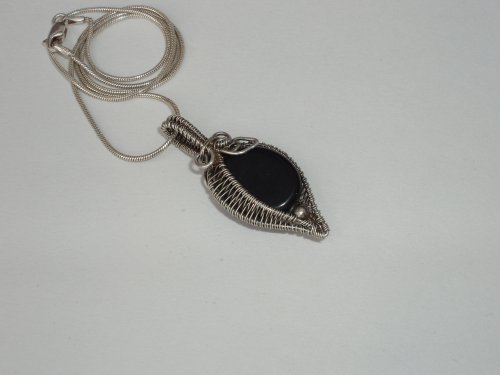



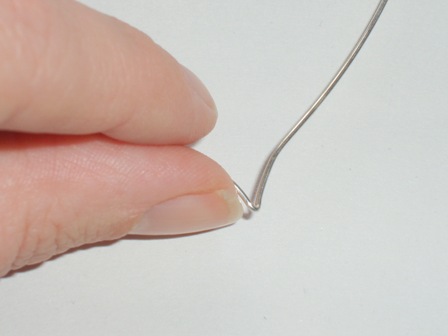
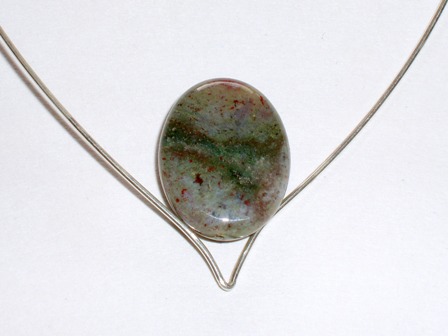
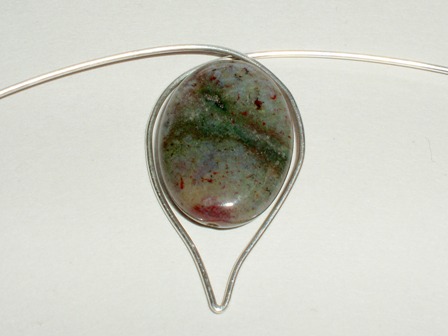
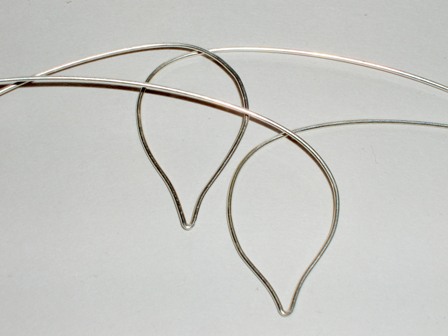



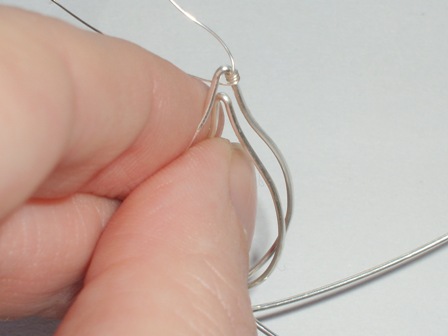


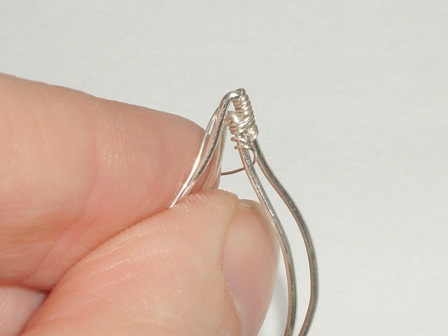
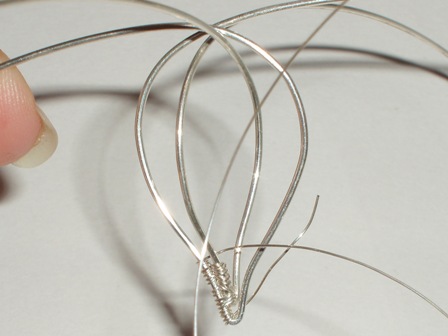
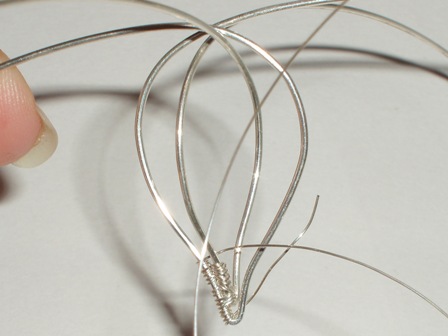
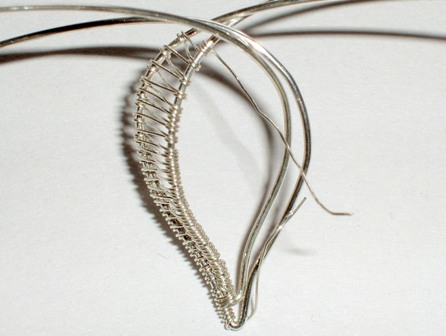
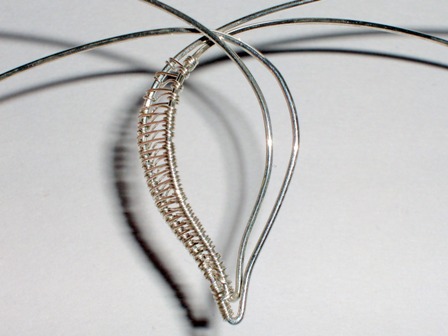

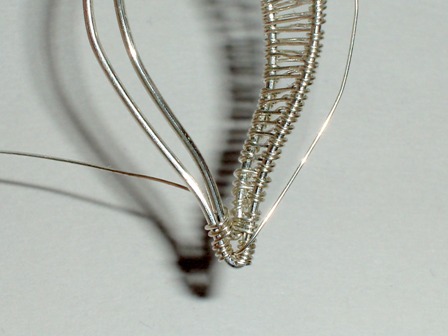
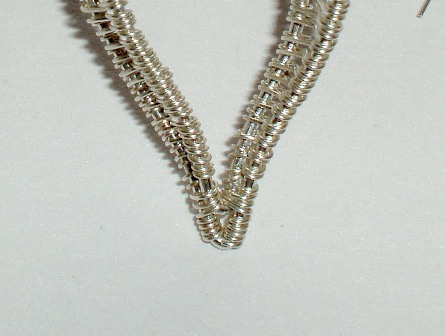
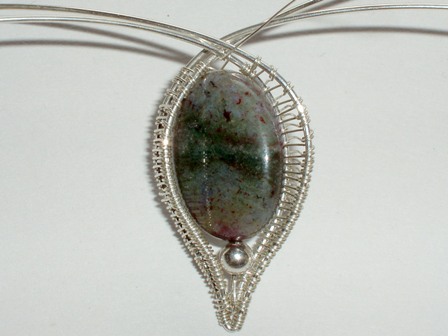
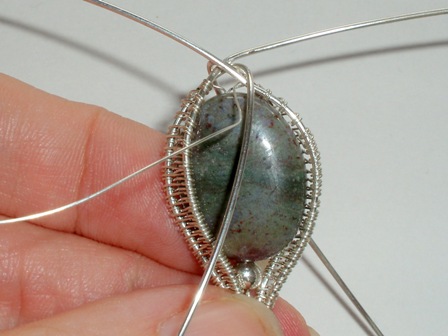

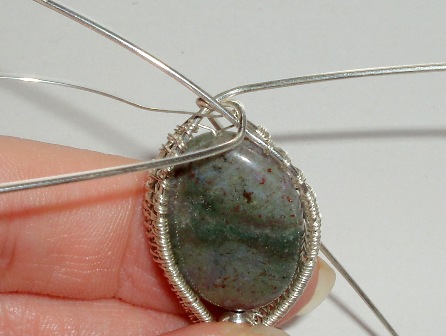
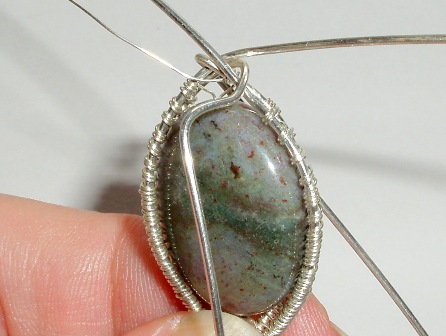

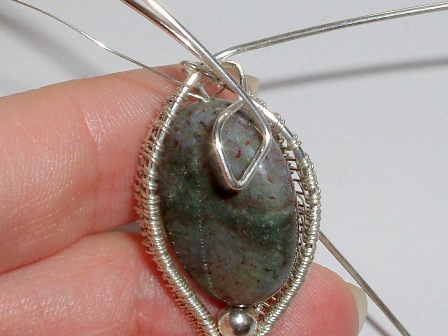
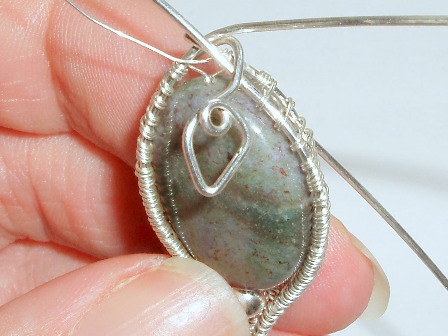
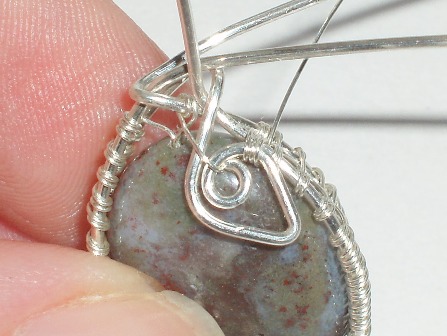

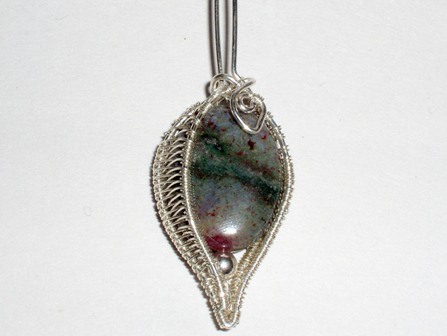
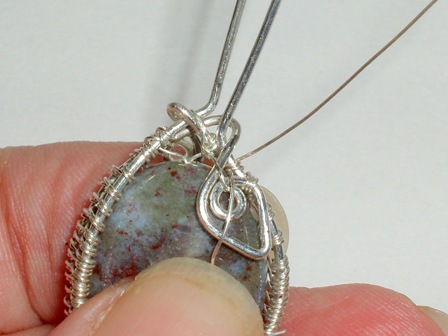
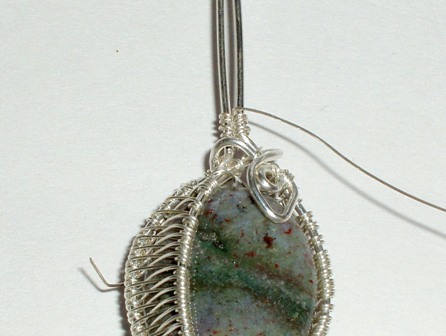

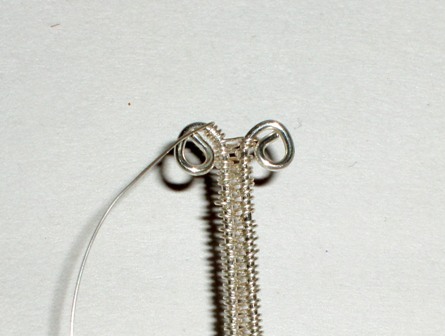
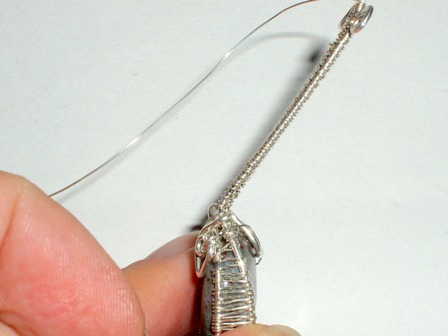

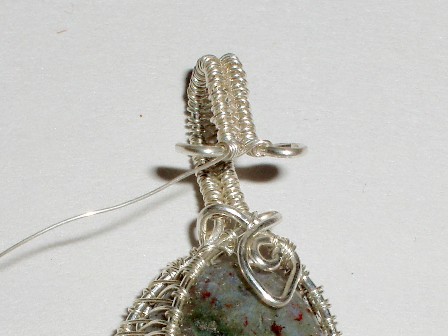

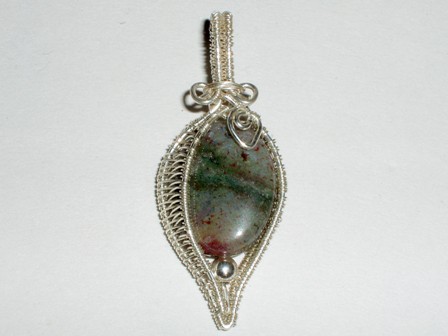














Brenda Trudell
June 5, 2017 at 10:58 pm
This is an awesome looking project. I love wire-work projects, and can hardly wait to try this one. Thank you so much.